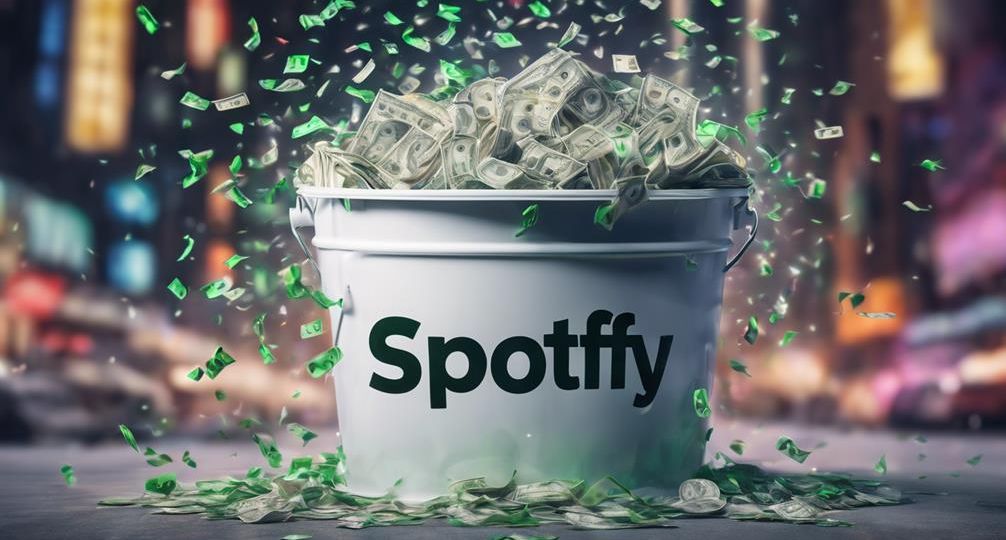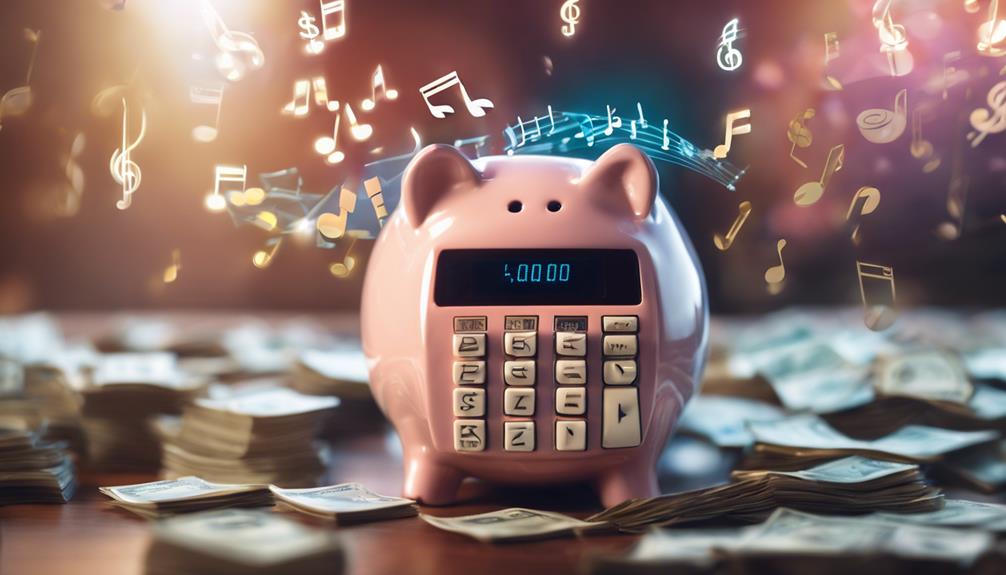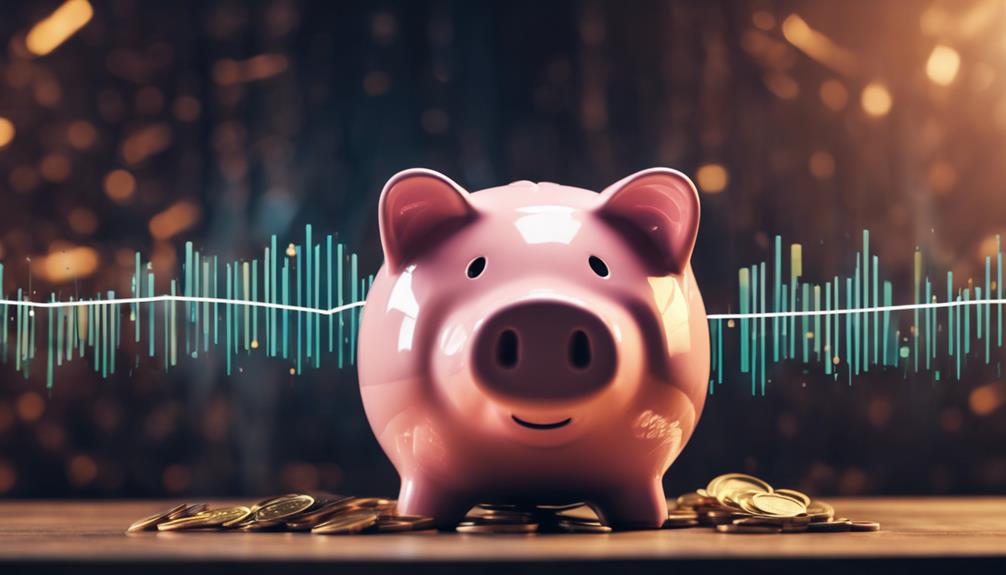
How many streams on Spotify is $10,000?
To earn $10,000 on Spotify, you’d typically need around 3.1 million streams, given the current average payout. However, Spotify’s royalty system is complex. Your earnings can vary depending on factors like track popularity, stream quality, and regional user base. Even premium subscriptions contribute more than free ones. As you take a deeper look, you’ll find strategies to boost your earnings, such as playlist placements and fan engagement. Understanding these dynamics will not only answer your question but also provide insights on how to maximize your Spotify payouts. There’s more to unpack as we navigate the streaming economy together.
Key Takeaways
- Spotify’s payment per stream fluctuates due to various factors like stream quality and playlist placement.
- To earn $10,000 on Spotify, you would approximately need around 3.1 million streams based on the current average payout rate.
- The earnings from streams also depend on the type of Spotify user – Premium subscribers generate more revenue than free users.
- Payout rates can vary by region due to the different number of users and revenue per region.
- Artists can boost their earnings by implementing effective marketing strategies, securing playlist placements, and creating quality content.
Understanding Spotify’s Royalty System

To comprehend how many streams on Spotify equate to $10,000, it’s crucial to first grasp Spotify’s intricate royalty system. This royalty system is a complex beast, often the center of royalty disputes due to its opaque nature. And let’s be honest, you’re not alone in your confusion. Many artists and record labels have raised issues regarding the fairness of this system, sparking a hot debate in the music industry.
Now, you’re probably wondering if there are any streaming alternatives to Spotify. And yes, there are. Platforms like Apple Music, TIDAL, and Amazon Music offer competitive rates. However, each has its own unique royalty system, and these aren’t devoid of scrutiny either.
In this rapidly evolving digital landscape, you have to stay vigilant and updated. The innovation in the streaming industry is constant, with new business models and technologies emerging regularly. But remember, understanding these royalty systems is crucial to maximizing your earnings.
How Spotify Calculates Payouts
While you may find the process complicated, it’s important to understand that Spotify calculates payouts based on a pro-rata model, and knowing this can greatly influence your streaming strategies. This model determines your slice of the royalty pie by comparing your total streams to the overall streams on the platform. This percentage then dictates the share of Spotify’s total payout you’ll receive.
Now, let’s explore the specifics. Spotify pools all of its revenue from subscriptions and advertisements. From that total, roughly 70% is allocated for royalty distribution to rights holders. This royalty pool is then divided among all streamed music, with each track’s share calculated according to the pro-rata model mentioned earlier.
Streaming algorithms play a pivotal role in this process. They track and count every play, ensuring accuracy in payout calculations. Surprisingly, a track needs to be played for at least 30 seconds to count as a stream, contributing to the total.
In essence, the amount you earn from Spotify isn’t a fixed rate per stream. It’s a complex interplay of overall streams, your individual streams, and Spotify’s total revenue. Understanding this framework can help you devise more effective, data-driven music marketing strategies.
Factors Influencing Spotify’s Payouts

Now that you have a grasp of how Spotify calculates payouts, let’s examine the various factors that can influence these earnings.
The first key determinant is Spotify subscribers impact. The more people that subscribe to Spotify, the larger the monthly revenue pool that’s available for distribution to rights holders. So, if Spotify’s subscriber base grows, you’re likely to see an increase in your earnings.
Another essential factor is the type of subscription. Premium subscribers generate more revenue than free users, so a track streamed by a premium user will result in a higher payout than one streamed by a free user.
Regional differences in payout also play a significant role. Rates can vary greatly from one country to another, as they’re based on the number of Spotify users and the overall revenue generated in each region. A stream in a country with a large number of Spotify users and high revenue may lead to a higher payout than a stream in a country with fewer users and lower revenue.
Understanding these factors is important for artists seeking to maximize their Spotify earnings. Remember, your payout isn’t just a function of the number of streams, but also the dynamics of Spotify’s user base and your audience’s geographical distribution.
Average Earnings Per Stream
Diving into the specifics, you’ll find that the average earnings per stream on Spotify are notoriously hard to pin down due to the fluctuating nature of the payout rate. Factors such as stream quality and artist agreements have a substantial impact on the earnings. Higher stream quality often commands higher rates, while artist agreements with record labels or distribution services can affect the final payout.
To illustrate this, let’s consider a table showing hypothetical average earnings per stream:
| Stream Quality | Average Earnings Per Stream |
|---|---|
| Low | $0.0010 |
| Medium | $0.0015 |
| High | $0.0020 |
| Very High | $0.0040 |
| Ultra | $0.0080 |
As you can see, even within a single platform like Spotify, earnings per stream can vary widely. This underscores the complexity of the streaming economy and its inherent variability. It’s important to understand these dynamics to navigate the music streaming landscape successfully. Remember, innovation in the music industry is not just about creating music; it’s also about understanding the business behind it.
Calculating Streams Required for $10,000

To calculate the number of streams needed to earn $10,000 on Spotify, you’ll first need to understand Spotify’s payment per stream. Given that this rate fluctuates, it’s critical to use an average rate for accurate calculations.
With this knowledge, you can then determine how many streams are necessary to meet your earnings goal.
Spotify’s Payment Per Stream
Exploring how many streams on Spotify equate to $10,000 requires a thorough examination of their payment per stream system, which is a detailed process influenced by multiple factors.
At the heart of this process is the impact of stream quality and playlist influence. High-quality streams tend to command higher prices, as the user experience is enhanced. Similarly, tracks that feature on popular playlists see a higher number of streams, which leads to increased earnings.
However, one must note that Spotify’s payment per stream isn’t fixed. It fluctuates based on various factors, including the country the stream originates from, the artist’s royalty agreement, and the listener’s subscription type.
To give you a detailed picture, here are a few key points to take into account:
- Stream quality: High-definition audio streams are often priced higher, impacting your overall earnings.
- Playlist influence: Being featured on popular playlists can greatly boost the number of streams, enhancing your revenue.
- Variable payment: Spotify’s payment per stream isn’t a constant figure but varies based on numerous factors.
Therefore, to fully grasp what $10,000 in Spotify streams entails, these complexities must be factored into your calculations.
Achieving $10,000 Earnings Goal
Calculating the exact number of streams needed to reach a $10,000 earnings goal on Spotify can seem like a challenging task, but by breaking down the variables, you’ll find it’s not as complex as it initially appears.
Start by understanding the base rate Spotify pays per stream, which averages around $0.0032. If you do the simple math, you’ll need around 3.1 million streams to make $10,000. However, this number could fluctuate depending on your agreement with your record label and distributors.
However, focusing solely on streams isn’t a sustainable strategy. It’s where earning diversification comes into play. You can increase your earnings by selling merchandise, tickets for live performances, or offering exclusive content. This multifaceted approach not only boosts your income but also strengthens your relationship with your fans.
Moreover, fanbase growth is essential in this equation. The larger your audience, the more streams you can potentially generate. By nurturing your fanbase through quality, engaging content, and regular interaction, you can significantly increase your stream count, moving you closer to your $10,000 goal.
Case Study: Successful Spotify Artists
Diving into the world of successful Spotify artists, you’ll find that their streaming numbers are astronomical, showcasing the potential for significant earnings on this popular music platform. A central part of this success is artist branding and strategic playlist placements. This approach helps artists reach a wider audience, increasing their stream count and, consequently, their earnings.
Consider these three artists:
- Artist 1: Known for their unique branding, they’ve garnered an impressive following. Their popularity on Spotify playlists has resulted in over a billion streams.
- Artist 2: With their music placed on multiple popular playlists, they’ve seen their streams skyrocket. Their well-crafted branding keeps listeners coming back.
- Artist 3: This artist’s innovative branding resonates with listeners. Coupled with their presence on high-traffic playlists, they’ve amassed a substantial number of streams.
Analyzing these case studies, it’s clear that effective branding and playlist placements are key factors in an artist’s success on Spotify. It’s not just about creating great music; it’s about innovatively presenting that music to the world. This combination of artistry and strategy opens the door to potentially lucrative earnings on Spotify.
Boosting Your Spotify Earnings

Now that we’ve examined how successful artists maximize their streams on Spotify, let’s shift our focus to strategies you can employ to increase your own earnings on this platform. To maximize your earning potential, you’ll need to be innovative, and that’s where marketing strategies and playlist placements come into play.
Effective marketing strategies are vital in expanding your audience and increasing your streams. Social media promotion, collaborations, and engaging with fans are just a few examples of the innovative strategies you can use.
Playlist placements also play a significant role. By getting your music on popular playlists, you increase its exposure, attracting more listeners and potentially more streams.
Take a look at this table for a summary:
| Strategy | Description |
|---|---|
| Marketing Strategies | Engage your audience through social media, collaborations, and other innovative approaches. |
| Playlist Placements | Get your music on popular playlists to increase exposure and attract more listeners. |
| Quality Content | Create high-quality music that listeners want to stream repeatedly. |
| Consistent Releases | Regularly release new music to maintain listener interest. |
| Fan Engagement | Interact with fans to build loyalty and encourage more streams. |
As you venture into the future of streaming, understanding how revenue is generated becomes vital. This knowledge is pivotal in maximizing your earnings in a rapidly evolving music industry.
With the shift to digital, traditional music monetization strategies may not hold; hence, it’s important to stay informed about emerging trends and adapt accordingly.
Understanding Streaming Revenue
In the labyrinth of streaming services, understanding how revenue is generated—especially on platforms like Spotify—is an essential step towards charting the future of streaming. Streamlining royalties and fostering revenue transparency will be pivotal in this journey.
Streaming revenue can seem complex, but you can break it down into three main components:
- Pay-per-stream: Spotify pays rights holders a certain amount for each stream. This amount varies widely, but it’s usually a fraction of a cent.
- Ads and Premium subscriptions: Free users generate revenue through ads, while Premium users contribute to revenue via their subscription fees.
- Market share: The number of streams an artist receives as a percentage of total Spotify streams also affects their payout.
It’s important to understand that Spotify doesn’t pay artists directly—it pays rights holders, who then distribute royalties to artists based on their agreements. Ensuring revenue transparency here is challenging, as the distribution often lacks clarity.
Future of Music Monetization
Exploring the future of streaming, you’ll find that music monetization is poised to undergo substantial changes, driven by technological advancements and evolving consumer preferences.
Monetization alternatives are cropping up, offering artists more control over their earnings. Patronage models, live stream ticketing, and direct-to-fan sales are reshaping the landscape, putting power back into the hands of creators.
Blockchain potential also can’t be ignored. This technology could revolutionize the music industry by providing transparent, efficient, and secure systems for music distribution and compensation. Artists could mint their music as NFTs (Non-Fungible Tokens), providing unique ownership rights that can be bought, sold, or traded. This wouldn’t only secure fair compensation for artists but also offer fans a deeper level of engagement with their favorite musicians.
However, it’s not just about adopting new technologies or models; it’s about shifting the power dynamics. You, as an artist, need to be at the center of this transformation, actively participating in shaping your financial future.

